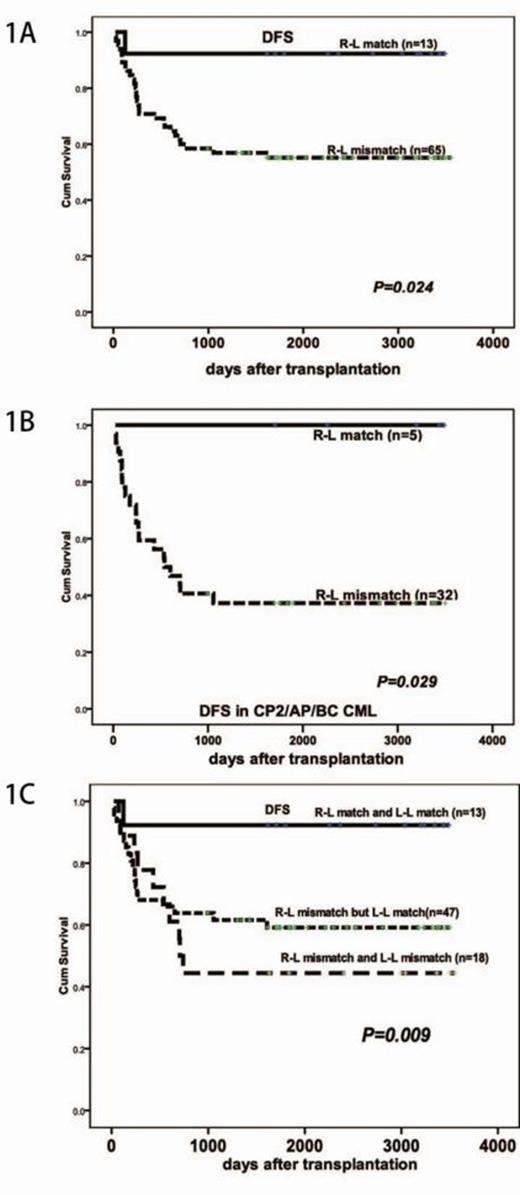Abstract
HLA-mismatched/haploidentical stem cell transplantation (SCT) is a feasible therapeutic option for advanced hematologic malignancies patients who lack an HLA-matched related or unrelated donor. The effect of NK alloreactivity in HLA haploidentcial SCT is still under debate and in particular in transplantation for chronic myeloid leukemia (CML) the data are very limited and with conflicting outcome.The goal of this study was to explorethe predictive roles of missing self model in our HLA-mismatched/haploidentical transplantation without T-cell-depletion in vitro in chronic myeloid leukemia patients, and to develop a simple algorithm on the basis of recipients and donor HLA-C and HLA-Bw4 gene content that can be used today to identify HLA-mismatched donors who will associated withbetter prognosis in T cell¨Creplete transplants.
We studied the HLA genotype of 78 donor-recipient pairs and the KIR genotype of their donor, who underwent unmanipulatedHLA-mismatched/haploidentical transplantation without T cells depletion in vitro during 2003-2009 in our center. To applythe missing ligand model, the first step was to divide ourdonor-recipient pairs into 2 groups according to the number of KIR ligand indonor and recipient, ie, 3 KIR ligands (“without missing self”) versus fewer than 3(“with missing self”). Meanwhile, to apply the KIR ligand-ligand model, donors who were classified as NK alloreactive against their recipientstermed KIR ligand mismatched donors throughout, possessedHLA class I KIRligand(s) which were missing in the recipients.
Among the 78 pairs of donor-recipients, 65 and 13 recipients receivedHLA¨Cmismatched/haploidentical transplants from “with missing self (R-L mismatch)” and “without missing self (R-L match)” donors, respectively. Using Ligand-ligand model, 59 and 19 recipients received haploidentical transplantation from “KIR ligand matched (L-L match)” and “KIR ligand mismatched (L-L mismatch)” donors, respectively. In contrast to Perugia's KIR ligand-ligand mismatched model or Handgretinger's KIR missing self model between donor-recipient pairs, we found that the 10-year disease free survival(DFS) rate were higher in patients received transplantation from “without missing self (R-L match)” donorscompared with those from “with missing self (R-L mismatch)” (92.3±7.4% vs. 55.2%±6.2%, p=0.024, Figure1A) , especially in high risk CML patients (100% vs. 37.2%±8.6%, p=0.029, Figure1B). When combined the above missing self model and Ligand-ligand model together, patients were subgrouped as receiving graft from “without missing self and without KIR ligand mismatch (R-L match and L-L match)” (n=13), “with missing self and without KIR ligand mismatch (R-L mismatch and L-L match)” (n=47), and “with missing self and with KIR ligand mismatch (R-L mismatch and L-L mismatch)” (n=18), respectively. Cox regression model showed the 10-yearDFSwas best predicted by the combination of missing self model and Ligand-ligand modelbetween recipients and donors pairs (HR 2.205(1.113-4.368), p=0.023, Figure1C). Meanwhile, donor KIR 2DS5 positive associated with higher DFS post-transplantation (84.2±8.4% vs. 56.8±7.7%, p=0.045) in CML patients. However, donor KIR haplotype B have no effect on DFS and overall survival after allogeneic hematopoietic stem cell transplantation for multiple myeloma
These data indicate thatpoor prognosis after transplantation is associated with the missing self and KIR ligand mismatch in recipients and T cell alloreaction may play apredominant role in this model.Based on recipients and donor HLA-C and HLA-Bw4 gene content, it could befeasible to identify HLA-mismatched donors who will predict the better prognosis in CML patients post T cell-replete transplant.
No relevant conflicts of interest to declare.
Author notes
Asterisk with author names denotes non-ASH members.


This feature is available to Subscribers Only
Sign In or Create an Account Close Modal